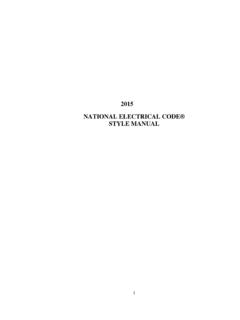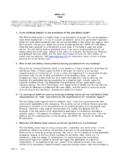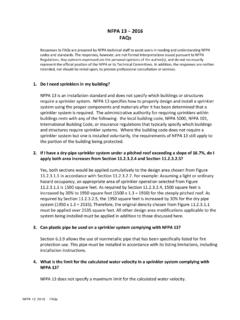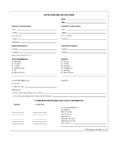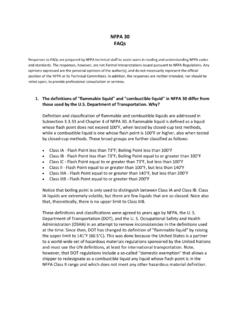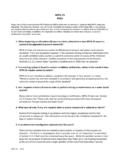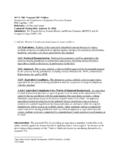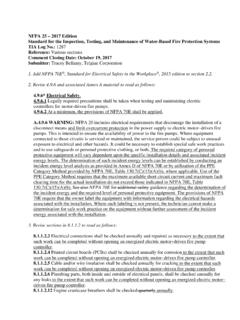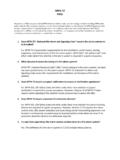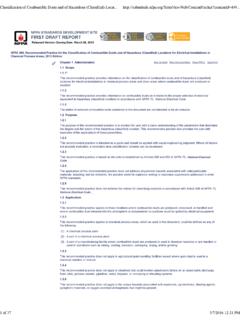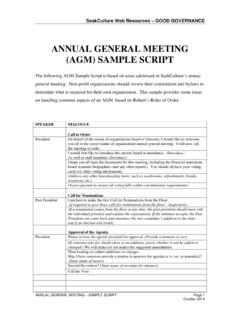Transcription of NFPA 72-2013 National Fire Alarm and Signaling Code TIA ...
1 nfpa 72-2013 National Fire Alarm and Signaling Code TIA Log No. 1188 Reference: Various Sections on Battery Comment Closing Date: June 19, 2015 Submitter: Herbert Hurst, Savannah River Nuclear Solutions, LLC 1. Add new IEEE Standards Association Publications to Chapter 2, Referenced Publications as and renumber existing through as through as follows: IEEE Standards Association Publications. Institute of Electrical and Electronics Engineers, 3 Park Avenue, New York, NY 10016-5997 IEEE StdTM 485, Recommended Practice for Sizing Lead-Acid Batteries for Stationary Applications, 2010. IEEE StdTM 1106, Recommended Practice for Installation, Maintenance, Testing, and Replacement of Vented Nickel-Cadmium Batteries for Stationary Applications, 2005 2.
2 Add the following definitions to General Definitions and renumber as required: Battery. Two or more cells connected together electrically. Cells can be connected in series or parallel, or both, to provide the required operating voltage and current levels. Common usage permits this designation to be applied to a single cell used independently. (SIG-TMS) Battery Capacity. The electrical energy available from a fully charged battery expressed in ampere-hours. (SIG-TMS) Battery Charger. A device used to restore and maintain the charge of a secondary battery in which electrical energy is converted to chemical energy. (SIG-TMS) Float-Charge. A constant-voltage charge applied to a battery to maintain it in a fully charged condition.
3 (SIG-TMS) Fully Charged. A condition synonymous with 100 percent state of charge. See , State Of Charge. (SIG-TMS) State Of Charge (SOC). The stored or remaining capacity of a battery at a given time expressed as a percentage of its rated capacity. (SIG-TMS) Trickle-Charge. A continuous, low rate, constant current charge given to a cell or battery to maintain the unit in a fully charged condition. See , Float Charge. (SIG-TMS) Battery Load Test. A controlled discharge of a battery at a specified rate for a given period of time until a final voltage is achieved in order to determine battery capacity. (SIG-TMS) Battery Unit (Unit). See , Unit (Multi-Cell). (SIG-TMS) Rechargeable Battery.
4 An electrochemical cell that is capable of being discharged and then recharged. (SIG-TMS) Cell. The basic electrochemical unit, characterized by an anode and a cathode, used to receive, store, and deliver electrical energy. [70, 2014] (SIG-TMS) Primary (Dry) Cell. A non-rechargeable electrochemical cell requiring periodic replacement such as a 9-volt alkaline cell. (SIG-FUN) Starved Electrolyte Cell. A cell in which liquid electrolyte is immobilized, also known as Absorbed Glass Mat (AGM) or Gel Cell. (SIG-TMS) Absorbed Glass Mat (AGM) Cell. A cell in which the liquid electrolyte is immobilized in fiberglass or polymeric fiber separators. (SIG-TMS) Gelled Electrolyte Cell (Gel Cell).
5 A cell in which the electrolyte is immobilized by addition of a gelling agent. (SIG-TMS) Unit (Multi-Cell). Multiple cells in a single container such as a 12-volt unit comprised of six 2-volt cells. (SIG-TMS) Valve-Regulated Lead-Acid (VRLA) Cell. A lead-acid cell that is sealed with the exception of a valve that opens to the atmosphere when the internal pressure in the cell exceeds atmospheric pressure by a pre-selected amount. VRLA cells provide a means for recombination of internally generated oxygen and the suppression of hydrogen gas evolution to limit water consumption. (SIG-TMS) 3. Delete , Primary Battery in its entirety. 4. Add a new (2) to read as follows and renumber current (2) thru (8) as (3) thru (9).
6 (2)* For battery operation less than 70 F ( C), battery calculations shall include a temperature correction for the minimum expected design temperature. 5. Add a new (2) to read as follows: (2) Batteries are sized with a 20-percent safety margin. However, in temperatures less than 70 F ( C), the battery will not be able to provide full rated amperes. IEEE 485 provides guidelines for additional margins based on anticipated minimum design temperatures. 6. Revise to read as follows: Cells Batteries shall be suitably insulated against ground faults. 7. Revise to read as follows: Cells Batteries shall be suitably insulated against short circuits crosses.
7 8. Revise to read as follows: Cells Batteries shall be mounted in such a manner so as to be protected from physical damage. 9. Add the following text to to read as follow: Battery and Charger. A separate storage battery and separate automatic charger shall be provided for starting the engine-driven generator and shall not be used for any other purpose. The battery shall be sized per nfpa 110, Chapter 5. 10. In Table , delete Item 9 and replace with new text to read as follows: 9. Batteriesa (a) Valve-Regulated Lead-Acid (VRLA) Batteries X Semiannually Ensure month and year of manufacture is marked in the month/year format on each battery cell/unit.
8 Verify marking of the month/year of manufacture on each battery cell/unit. Replace any cell/unit if Alarm equipment manufacturer s replacement date has been exceeded. X Semiannually Verify tightness of battery connections. Inspect terminals for corrosion, excessive container/cover distortion, cracks in cell/unit or leakage of electrolyte. Replace any battery cell/unit if corrosion, distortion, or leakage is observed. (b) Primary (dry) cell X Semiannually Verify marking of the month/year of manufacture. Replace if Alarm equipment/battery manufacturer s replacement date has been exceeded. Replacement date not to exceed 12 months. Verify tightness of connections. Inspect for corrosion or leakage.
9 Replace any battery cell/unit if corrosion or leakage is observed. 11. Add a new footnote to Table to read as follows: aFor other than VRLA or Primary (dry) cell batteries, refer to the battery manufacturer s instructions or the appropriate IEEE standard; IEEE 450 for vented lead-acid, IEEE 1106 for Nickel-cadmium. 12. Renumber Table Item 7 as Item 8 and revise to read as follows: 78. Secondary (standby) power supply c X X Annually Disconnect all primary (main) power supplies and verify the occurrence of required trouble indication for loss of primary power. Measure or verify the system s standby and Alarm current demand and verify the ability of batteries to meet standby and Alarm requirements using Alarm equipment manufacturer s data and verify that the rated capacity of the battery exceeds the system s standby and Alarm requirements by the applied safety factor.
10 Operate general Alarm systems for a minimum of 5 minutes and emergency voice communications systems for a minimum of 15 minutes . Reconnect primary (main) power supply at end of test. 13. Renumber Table Item 8 as Item 7 to read as follows: 87 Uninterruptable power supply (UPS). X Annually If a UPS system dedicated to the system is used as a required power source, verify by the building owner operation of the UPS system in accordance with nfpa 111, Standard on Stored Electrical Energy Emergency and Standby Power Systems. 14. In Table , delete Item 9 and replace with new text to read as follows: 9. VRLA Battery and Chargerq (a) Temperature test (b) Charger testr X X Semiannually Semiannually Prior to conducting any battery testing, verify by the person conducting the test, that all system software stored in volatile memory is protected from loss.
